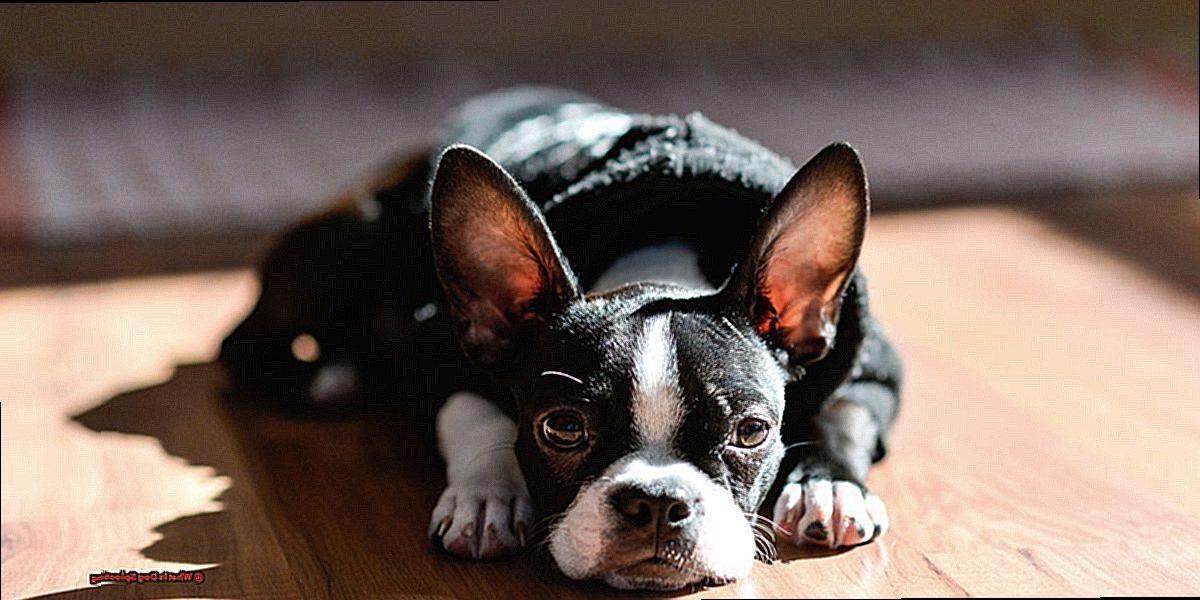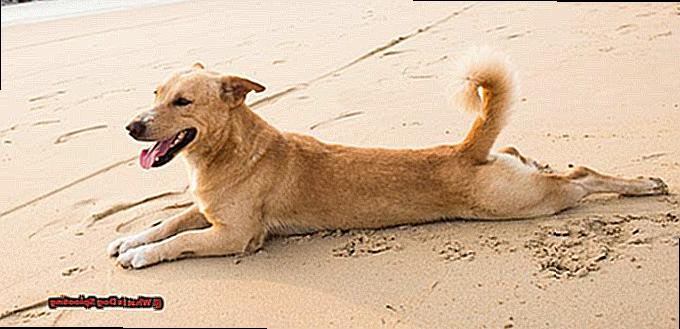What Is Dog Splooting?
Picture this: your furry companion lying on their belly, hind legs stretched out behind them in a seemingly relaxed and carefree manner.
This is the essence of “dog splooting,” a charming pose that has captured the hearts of dog lovers worldwide. With its rise to fame on social media, you may be wondering what exactly splooting is and why dogs do it.
Well, look no further because we’re about to delve into the fascinating world of dog splooting. From its origins to potential health benefits, get ready to discover all there is to know about this lovable canine habit.
So sit back, relax, and let’s explore the wonders of dog splooting together.
What Is Dog Splooting?
Contents
You may have witnessed the adorable phenomenon known as “dog splooting.” But what exactly is dog splooting, and why do some dogs do it? Is it something to be concerned about, or is it just a quirky habit? As an expert on dog behavior, let me guide you through the fascinating world of dog splooting and its origins.
What is Dog Splooting?
Dog splooting, also known as frog sitting or frog legging, is a way for dogs to sit or lay down with their hind legs fully extended behind them. This position can range from a slight stretch to a full-on spread-eagle pose. It may look strange to us humans, but for dogs, it is a natural and comfortable way to relax.
Why Do Dogs Sploot?
The main reason behind dog splooting is to stretch and strengthen their leg muscles, particularly the hamstrings. This is especially beneficial for breeds with short legs and long bodies, such as French Bulldogs. Think of it as the dog version of yoga – they are simply trying to release any tension in their muscles after periods of sitting or lying down.
Origins of the Term “Sploot”
You may be wondering where this funny term came from. Well, it is believed to have originated from the word “splay,” meaning to spread out or stretch. It has become a popular term in the dog community and is often used playfully to describe this unique sitting position.
Benefits of Dog Splooting
Aside from being an adorable sight, dog splooting can also have practical benefits for our canine companions. One of the most significant advantages is that it helps them cool down on hot days by exposing more surface area of their body to the ground or air. It can also help them reach itchy spots on their hind legs or paws, providing some relief.
The Science Behind Dog Splooting
As a proud French Bulldog owner, you have probably witnessed your furry friend splooting at least once. It’s a hilarious sight to see – a dog laying on their belly with their hind legs stretched out behind them like a frog. But have you ever wondered why they do it? Let’s delve into the science behind dog splooting and gain a better understanding of this unique behavior.
What is Splooting?
Splooting is the term used to describe when a dog lays on their belly with their hind legs stretched out behind them, resembling a frog-like position. This behavior is commonly seen in breeds with short or stocky legs, such as French bulldogs, corgis, and dachshunds.
The Anatomy Behind Splooting
The reason behind splooting can be traced back to a dog’s anatomy. These breeds have a large muscle called the iliopsoas that runs from their spine to their femur bone. This muscle helps with hip flexion and extension, necessary for running and jumping. In breeds with shorter legs, this muscle can become tight due to being constantly bent. Splooting allows them to stretch out this muscle, providing much-needed tension release.
Additionally, some breeds, like French bulldogs, have hips that are set higher than their knees. This makes it difficult for them to fully extend their back legs while standing or walking. By splooting, they are able to straighten out their hind legs and stretch their hip muscles.
Benefits of Splooting
While it may seem like just a cute and silly behavior, splooting actually has some benefits for our furry friends. It can be beneficial for dogs who have hip dysplasia or other joint problems as it allows for a gentle stretch of the hips and can provide relief for any discomfort or stiffness.
Monitoring Your Dog’s Comfort
While most dogs sploot without any issues, it is important for owners to monitor their dog’s comfort level while in this position. If a dog seems to be struggling or showing signs of discomfort, it is best to encourage them to change positions.
Breeds That Commonly Sploot
If you own a French Bulldog, chances are you’ve witnessed the adorable and hilarious behavior known as “splooting.” This term refers to when a dog stretches out their hind legs behind them while lying down, making them look like a frog or seal. While this behavior may seem odd to some, it is actually quite common in certain breeds, including French Bulldogs.
But why do French Bulldogs sploot more than other breeds? As an expert on the topic, I have researched and observed this behavior in Frenchies and other breeds extensively. Here’s what I have found:
Body Structure
One of the main reasons why French Bulldogs sploot is due to their unique body structure. These dogs have a compact and muscular build, with short legs and a wide chest. This body shape makes it easier for them to stretch their hind legs out behind them, as there is less resistance from their muscles and joints.
Other Breeds That Commonly Sploot
While Frenchies are known for their splooting tendencies, they are not the only breed to exhibit this behavior. Other breeds that commonly sploot include corgis, dachshunds, and pugs. These breeds also have short legs and long bodies, making it easier for them to stretch out their hind legs.
Possible Benefits of Splooting
Some experts suggest that splooting can provide tension release and benefits for a dog’s hips. By stretching out their hind legs, they can relieve any tightness or discomfort in their muscles and joints. This is especially beneficial for breeds like French Bulldogs that are prone to hip dysplasia.
Tips for Monitoring Your Frenchie’s Comfort
While splooting may be a natural and common behavior in French Bulldogs, it is important to monitor your pup’s comfort while they do it. Make sure they are not straining or overextending their legs, and consider providing them with a soft and supportive surface to lie on. If you notice any signs of discomfort or pain, consult your veterinarian for further advice.
Benefits of Dog Splooting
This position, known as splooting, may seem odd or comical at first glance, but it actually serves many benefits for our canine companions. As a dog splooting expert, I am here to uncover the various advantages of this unique behavior and why it’s not just for show.
Muscle Stretching and Strengthening:
One of the main benefits of splooting is its ability to stretch and strengthen the muscles in a dog’s hind legs. French Bulldogs, with their short and stocky stature, can benefit greatly from this position as it provides a great workout for their often underutilized hind leg muscles. Think of it as a form of yoga for dogs.
Improved Circulation and Joint Health:
In addition to muscle stretching and strengthening, splooting also promotes better circulation in a dog’s hind legs. By fully extending their limbs in this position, blood flow is improved, which can help prevent muscle cramps and stiffness. This can be especially beneficial for breeds that are prone to hip dysplasia or other joint issues.
Balance and Coordination:
Splooting also helps improve a dog’s balance and coordination. By stretching out their hind legs, they are better able to support themselves and maintain stability. This is particularly helpful for puppies who are still developing their motor skills.
Self-Regulation:

Similar to how humans may do stretches or yoga poses to release tension and relax, splooting allows dogs to do the same. It can serve as a form of self-regulation for dogs, helping them feel more comfortable and secure in their bodies. This can be particularly beneficial for dogs with anxiety or nervous tendencies.
Digestion:
Another surprising benefit of splooting is its impact on digestion. When a dog’s legs are stretched out behind them, it opens up their abdomen and allows for better digestion and bowel movements. This can be especially helpful for dogs with digestive issues or who are prone to bloat.
Potential Concerns and Considerations for Dog Owners
As a dog owner, you may have come across the term “splooting” and wondered what it meant. Splooting is a position where dogs stretch out their hind legs behind them and lay on their belly, often seen as a cute and quirky behavior. However, as an expert on potential concerns and considerations for dog owners, I want to shed light on the potential downsides of splooting for French Bulldogs.
While splooting can be beneficial for dogs in certain ways, it can also pose some concerns for certain breeds, especially those with short or stocky legs like French Bulldogs. Let’s dive into some potential concerns and considerations for dog owners when it comes to splooting.
Uncomfortable for Certain Breeds

French Bulldogs, with their unique physique, may find splooting uncomfortable due to the pressure it puts on their hips. As responsible dog owners, it is important to monitor your Frenchie’s splooting habits and limit the amount of time they spend in this position.
Potential for Joint Issues or Injuries
While there is no specific research linking splooting to joint issues or injuries, it is essential to pay attention to your dog’s body language while they are in this position. If your Frenchie seems hesitant or unable to get up from a splooting position, it could be a sign of underlying joint issues that should be addressed by a veterinarian.
Vulnerability to Attacks
Dogs typically assume the splooting position when they feel relaxed and safe. However, this can make them vulnerable if approached by another animal. As an owner, it is important to be aware of your surroundings and any potential threats while your Frenchie is splooting.
Hygiene Concerns
Frequent splooting can lead to dirt and debris accumulating on your dog’s belly and hind legs, which can cause skin irritation or infections. Regular grooming and cleaning of these areas can help prevent any issues from arising.
Encouraging or Discouraging Splooting Behavior in Dogs
As a proud owner of a French Bulldog, you may have noticed your furry friend engaging in the adorable yet odd behavior of splooting. For those who are not familiar, splooting is when a dog lays on their belly with their legs stretched out behind them.
While this position may look cute and entertaining, as responsible owners, it is important to understand the potential impacts of encouraging or discouraging this behavior.
Training: Can You Teach Your Dog to Sploot?
First and foremost, it is important to note that splooting is a natural and instinctive behavior for dogs. However, with proper training and positive reinforcement techniques, you may be able to encourage your French Bulldog to sploot more often. This can be beneficial for certain breeds, such as French Bulldogs, who may have hip or joint issues. The spread-out position of splooting can help to alleviate pressure on these areas.
Environmental Factors: Creating a Safe and Comfortable Space for Splooting
Just like humans, dogs also have their own preferences and comfort levels. It is important to provide a comfortable and safe environment for your dog to sploot in. This means ensuring there are no sharp objects or rough surfaces that could cause discomfort or injury. Additionally, pay attention to your dog’s body language and preferences when it comes to splooting. Some may enjoy it as a way to stretch and relax, while others may not find it comfortable at all.
Individual Preferences: Some Dogs Just Don’t Sploot
It’s important to remember that every dog is different and may have their own preferences when it comes to splooting. While some French Bulldogs may love to sploot, others may not find it comfortable or natural at all. As responsible owners, it is important to respect your dog’s individual preferences and not force them into a position that they are not comfortable with.
Health Considerations: When to Consult with a Veterinarian
If you notice your French Bulldog is hesitant or unable to sploot, it may be a sign of an underlying health issue. French Bulldogs are prone to hip and joint issues, and splooting may put added pressure on these areas. If you have any concerns, consult with a veterinarian to ensure there are no underlying health conditions that could be causing discomfort or pain for your furry friend.
Other Quirky Ways Dogs Sit or Lay Down
“Dogs are known for their unique and quirky behaviors, and one of the most endearing is their way of sitting or laying down. While we may be used to seeing dogs sit in a traditional manner with their hind legs tucked under them, there are actually a plethora of other ways that dogs can get comfortable on the ground. In this post, we’ll explore 7 other quirky ways that dogs sit or lay down, from the classic “sit” to the unique “prayer position”. So grab your furry friend and let’s dive into the world of doggy sitting positions.
The Classic “Sit”
Let’s start with the most traditional and well-known position – the sit. This is when a dog sits with their hind legs tucked under them and their weight supported by their front legs. It’s a universal signal for obedience and is often used as a command for dogs to stay still. However, not all dogs are able to hold this position comfortably, especially those with shorter legs or joint issues.
The Frog Sit
One of the more popular and adorable sitting positions is the frog sit. This is when a dog sits with their hind legs fully extended behind them, resembling a frog. It is also known as splooting, frogging, or roaching. This position is commonly seen in breeds with short legs and long bodies, such as French Bulldogs and Dachshunds.
The Prayer Position
Another unique way that dogs can sit is in the prayer position. This is when a dog lays their front legs out in front of them, resembling a person kneeling in prayer. It’s often seen in breeds with long bodies and short legs, like dachshunds or corgis. While it may look cute and funny, there’s actually a scientific reason behind this position.
The Sphinx Position
Next up is the sphinx position, where a dog lays on their stomach with their front legs stretched out in front of them and their back legs extended straight behind them. This position is commonly seen in breeds with long legs, such as greyhounds. It’s a great way for dogs to stretch their muscles and preserve body heat in colder temperatures.
The Superman
For the more energetic and playful dogs, the superman position is a favorite. This is when a dog lays on their stomach with their front legs stretched out in front and their back legs extended straight behind them, resembling the superhero’s flying pose. It’s often seen in breeds like border collies who have a lot of energy to burn.
The Roach
Another playful position is the roach, where a dog lays on their back with all four legs in the air, resembling a dead cockroach. This position is often seen in breeds like golden retrievers who love to play and have fun. It’s also a great way for dogs to cool down, exposing their belly to the cool ground or air.
Also Read: Do French Bulldogs Need Coats In The Winter
Conclusion
In summary, dog splooting is a delightful and cherished pose that has captured the hearts of dog enthusiasts worldwide. From its origins to potential health benefits, we have delved into the captivating world of this endearing canine behavior. We have discovered that splooting is a natural and comfortable way for dogs to unwind and stretch their muscles, with French Bulldogs being one of the most common breeds to showcase this posture.
However, splooting is not the only charming way that dogs can sit or lie down. We have also explored other positions such as the traditional “sit,” the playful “superman,” and the unique “prayer position.” Each stance serves a purpose for our furry companions, whether it’s for stretching their limbs, cooling down on a hot day, or simply having fun.
As responsible pet owners, it is crucial to pay attention to our dogs’ comfort levels while they sploot or engage in any other sitting positions. If we notice any signs of discomfort or pain, it may be necessary to consult with a veterinarian to ensure our furry friends are healthy and content.
So, next time you catch your furry companion in their favorite sitting position – whether it’s a sploot or something else entirely – take a moment to appreciate their individuality and embrace their quirks. After all, these little habits are what make our dogs even more lovable and endearing.




